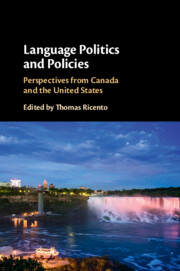Book contents
- Language Politics and Policies
- Language Politics and Policies
- Copyright page
- Dedication
- Contents
- Figures
- Tables
- Contributors
- Preface
- Contributor Personal Statements
- Introduction
- Part I Theoretical Orientations
- Part II The United States Context
- Part III The Canadian Context
- 11 Heritage Language Education Policies and the Regulation of Racial and Linguistic Difference in Ontario
- 12 A Foucauldian Approach to Language Policy in Canada
- 13 Promises, Acts, and Action
- 14 Language, Land, and Stewardship
- 15 A Land of Immigration and Official French–English Bilingualism
- 16 Ethnocultural and Linguistic Diversity
- Index
- References
13 - Promises, Acts, and Action
Indigenous Language Politics in Canada
from Part III - The Canadian Context
Published online by Cambridge University Press: 18 July 2019
- Language Politics and Policies
- Language Politics and Policies
- Copyright page
- Dedication
- Contents
- Figures
- Tables
- Contributors
- Preface
- Contributor Personal Statements
- Introduction
- Part I Theoretical Orientations
- Part II The United States Context
- Part III The Canadian Context
- 11 Heritage Language Education Policies and the Regulation of Racial and Linguistic Difference in Ontario
- 12 A Foucauldian Approach to Language Policy in Canada
- 13 Promises, Acts, and Action
- 14 Language, Land, and Stewardship
- 15 A Land of Immigration and Official French–English Bilingualism
- 16 Ethnocultural and Linguistic Diversity
- Index
- References
Summary
This chapter addresses the current political climate in Canada with respect to language politics through an examination of historical settler-colonial and Indigenous relations. The focus is the interplay, and the inherent contradictions, between the state and Indigenous language interests. This includes a consideration of language and education rights, policies, and moves to reconciliation on behalf of state and Indigenous actors. The diverse goals and outcomes of Indigenous educational policies and practices will be examined with a focus on the Canadian Arctic, the role of Indigenous land-based pedagogies, and the necessary conceptualization and reaffirmation of languages as unbounded, action-oriented practices that resist objectification and enumeration.
Keywords
- Type
- Chapter
- Information
- Language Politics and PoliciesPerspectives from Canada and the United States, pp. 244 - 262Publisher: Cambridge University PressPrint publication year: 2019



